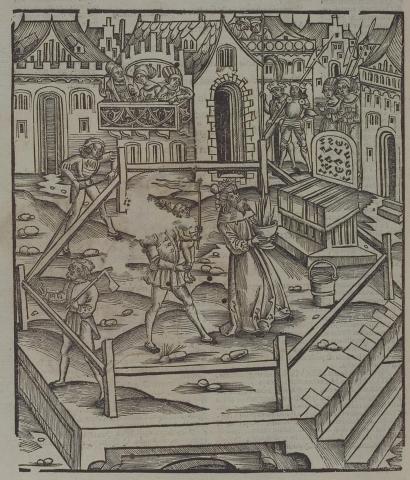Annotations
In the image, men build a fighting ring, a contemporary equivalent to Vergil's description of soldiers measuring out a field for the combat (116-7). The ring is placed directly outside the walls of the city. In the middle of the ring, a priest holding fire in a bowl and standing near a pail of water prepares an altar for a joint sacrifice attended by both the Trojans and the Rutulians (117-20). Next to the priest, an attendant holds what appears to be a statuette of one of the gods shared by the two groups. In the upper right corner, a few Trojan soldiers and women stand to watch the rites, while in the top center, a few Latin townspeople watch from the city (121-33).
Woodcut illustration from the “Strasbourg Vergil,” edited by Sebastian Brant: Publii Virgilii Maronis Opera cum quinque vulgatis commentariis expolitissimisque figuris atque imaginibus nuper per Sebastianum Brant superadditis (Strasbourg: Johannis Grieninger, 1502), fol. 394v, executed by an anonymous engraver under the direction of Brant.


Sebastian Brant (1458-1521) was a humanist scholar of many competencies. Trained in classics and law at the University of Basel, Brant later lectured in jurisprudence there and practiced law in his native city of Strasbourg. While his satirical poem Das Narrenschiff won him considerable standing as a writer, his role in the transmission of Virgil to the Renaissance was at least as important. In 1502 he and Strasbourg printer Johannes Grüninger produced a major edition of Virgil’s works, along with Donatus’ Life and the commentaries of Servius, Landino, and Calderini, with more than two hundred woodcut illustrations. (Annabel Patterson)